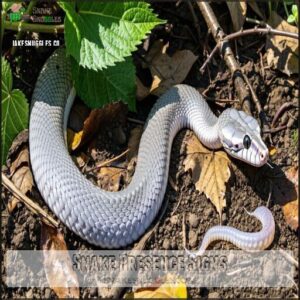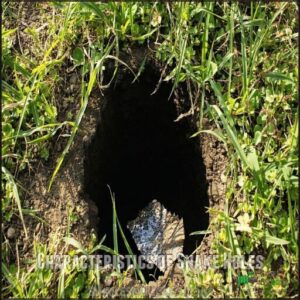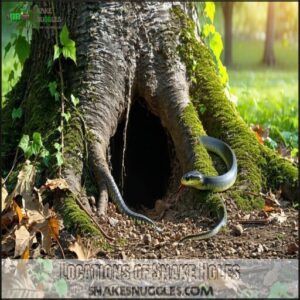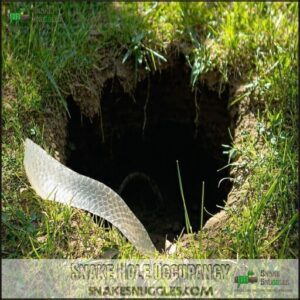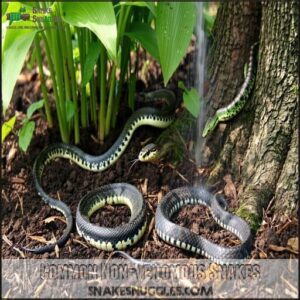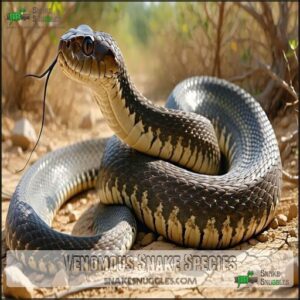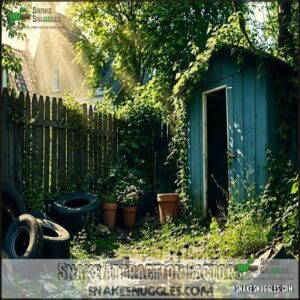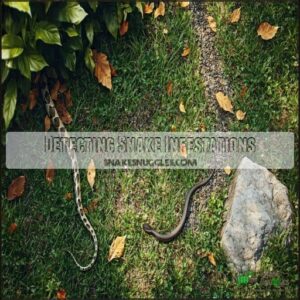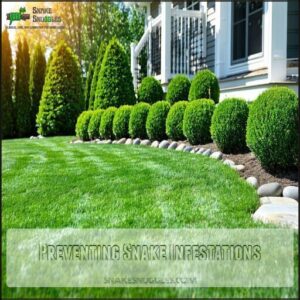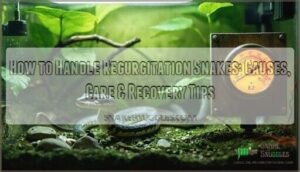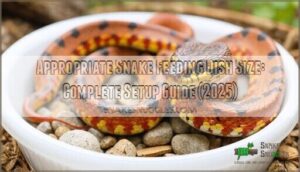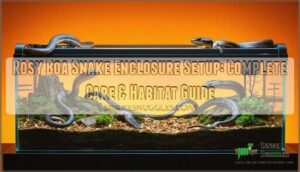This site is supported by our readers. We may earn a commission, at no cost to you, if you purchase through links.
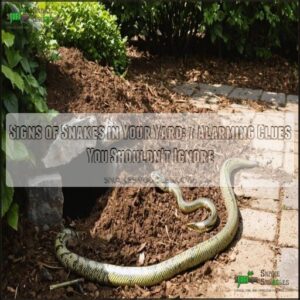 Spotting signs of snakes in your yard can feel like solving a mystery. Look for shed snake skins—they’re like nature’s version of a calling card.
Spotting signs of snakes in your yard can feel like solving a mystery. Look for shed snake skins—they’re like nature’s version of a calling card.
Slithery tracks in loose soil or sand are another giveaway, and unusual, small holes might indicate hidden snake shelters. You might even notice snake droppings, which look like bird poop but often include bits of fur or bones.
Audible warnings like hissing or a faint rustling in bushes are also worth noting. Keep an eye out for these clues, and remember, knowing the signs is the first step to keeping your yard safe and snake-free!
Table Of Contents
- Key Takeaways
- Snake Presence Signs
- Identifying Snake Holes
- Snake Hole Occupancy
- Snake Species Identification
- Snake Attraction Factors
- Detecting Snake Infestations
- Preventing Snake Infestations
- Frequently Asked Questions (FAQs)
- How can you tell if you have a snake in your yard?
- What does a snake hole look like in a yard?
- How do you detect the presence of a snake?
- What attracts snakes to yard?
- How do I know if there are snakes in my yard?
- How can you tell if a snake is around?
- How do you know if a snake is around?
- How to tell if there’s a snake in your yard?
- Where do snakes hide in backyard?
- What attracts snakes around your house?
- Conclusion
Key Takeaways
- Check for shed snake skins, slither tracks, or tubular droppings with white caps near shrubs or in soil.
- Listen for faint rustling or hissing sounds in bushes and look for musky odors, especially in shaded or cluttered areas.
- Watch for circular holes, 0.5 to 3 inches wide, often near grass, foundations, or tree bases—these may be occupied burrows.
- Remove attractants like rodents, overgrown vegetation, woodpiles, and standing water to make your yard less snake-friendly.
Snake Presence Signs
You’ll find several telltale indicators that serpents have claimed territory in your yard.
Shed skins, distinctive S-shaped tracks in soil, and tubular droppings with white caps are the signs to look out for.
Recognizing these physical signs early enables you to take appropriate action before an unexpected encounter occurs, whether you’re dealing with beneficial garden snakes or potentially dangerous species.
Discarded Snake Skins
Finding discarded snake skins in your yard is a definitive sign of snake presence.
Discarded snake skins in your yard signal active snake territory, revealing their size, habits, and recent movements.
When snakes grow, they shed their translucent, leathery skin approximately every two months.
This molting process leaves behind valuable clues:
- Size indication: The shed skin reveals the snake’s actual length and diameter
- Hiding spots: Skins often appear near snake habitats like trees or shrubs
- Recent activity: Fresh, intact skins suggest the snake is still nearby
Slither Tracks and Droppings
When you’re investigating potential snake presence in your yard, slither tracks and droppings provide definitive evidence of recent activity.
Snake tracks vary dramatically based on movement patterns, while their droppings offer key species identification clues.
| Track Type | Movement Pattern | Species Variation |
|---|---|---|
| S-shaped | Lateral undulation | Most common snakes |
| Straight | Rectilinear | Large constrictors |
| Accordion | Concertina | Climbing species |
| Wide waves | Slide pushing | Fast-moving species |
Snake droppings resemble dark tubular scat with white urea caps, often containing bones or fur from prey.
Audible and Olfactory Clues
While track identification helps spot snakes, your other senses can also alert you to their presence.
Snakes leave behind distinctive audible and olfactory clues that shouldn’t be ignored.
- Unexpected hissing or rustling sounds from storage areas could mean a snake has made itself at home
- Musky, skunk-like odors in confined spaces often signal snake territory
- Missing rodents or fewer small mammals may indicate a hungry predator
- Dark tubular droppings with white caps near hiding spots are tell-tale snake feces
Identifying Snake Holes
You’ll quickly recognize snake holes by their circular openings measuring between 0.5 to 3 inches in diameter, though snakes don’t create these holes themselves but rather occupy abandoned burrows made by other animals.
You can find these reptile accommodations near your property’s foundation, in grassy areas, within concrete cracks, or around tree bases where snakes seek shelter from predators and harsh weather conditions, often utilizing them as reptile accommodations and seeking shelter from predators.
Characteristics of Snake Holes
Snake holes are round, varying from 0.5 to 3 inches in diameter, and fit the snake’s body tightly.
Their shape is smooth and circular, often located in grass, near foundations, or under shrubs.
Snakes don’t burrow themselves but use abandoned rodent burrows.
These holes provide shelter, helping snakes regulate temperature and avoid predators.
You might spot shed skin or droppings nearby, suggesting recent visits.
To prevent snakes from using these burrows, consider a rodent burrow blocker.
While small, these snake holes in grass or your property’s edge can indicate active hidden residents.
Locations of Snake Holes
Snake holes can appear in some surprising spots.
They’ve a circular shape and size that varies between 0.5 to 3 inches.
You’ll often find them in:
- Grass holes from abandoned rodent burrows.
- Tree cavities where snakes hide in decayed or hollowed-out trunks.
- Foundation cracks along walls or steps, especially near clutter.
- Underground burrows left by chipmunks or moles.
- Gardens and compost piles, which offer shelter and food sources.
Always check surroundings carefully, as these areas can attract snakes seeking cover.
To prevent snakes from using these entry points, consider using an effective burrow blocker.
Snake Hole Occupancy
If you’re wondering whether a hole in your yard is home to a snake, there are a few key signs to watch for.
From shed skin nearby to the absence of debris around the opening, these clues can help you confirm if it’s currently occupied by a snake.
Indicators of Occupied Holes
A freshly shed snakeskin near a burrow means the hole is likely occupied, as snakes often molt in safe spots.
Dropping analysis can confirm activity—snake droppings, dark brown with a white tip, may sit nearby. Consistent activity like snake trails or sightings around the area strengthens this indication.
If spiderwebs are absent, it suggests the hole is actively used. For certainty, professional confirmation is best, as these clues highlight snake behavior without risking close encounters with potentially occupied snake holes.
Consider using a camera for burrows to safely investigate potential snake habitats.
Signs of Vacant Holes
When checking for vacant snake holes, look for indicators like spiderwebs present or debris accumulation around the opening.
These suggest no recent activity.
Vacant holes often lack fresh shed skin, droppings, or signs of movement.
Pay attention to the hole condition—untouched entrances may confirm the absence of snakes.
Snake holes in trees, foundations, or burrows that remain undisturbed are likely empty.
Rodent burrows are often repurposed by snakes seeking shelter.
Always approach these areas with care, as some wildlife may still find these spaces appealing for shelter and there may be other signs of recent activity.
Snake Species Identification
Learning to identify snake species in your yard helps you understand the risks and benefits they bring to your environment.
By observing their patterns, colors, and behaviors, you can distinguish between harmless visitors and potentially dangerous ones.
Common Non-Venomous Snakes
In your yard nonvenomous snakes like the Garter Snake, Rat Snake, and Kingsnake are common and can actually be quite helpful.
These garden snakes feed on pests like rodents and insects, forming a natural pest control team.
Their diet and behavior make them easy to identify—Garter Snakes love moist environments, Rat Snakes often climb trees, and Kingsnakes are known for their bold black-and-white patterns.
Learning snake identification tips helps you spot these harmless visitors, reducing fear and enhancing your garden’s ecosystem balance.
Venomous Snake Species
Venomous snake species are fascinating yet formidable creatures to watch for.
Their venom delivery varies by type and region, making snake identification essential for safety. Knowing symptoms like swelling, dizziness, or nausea from snake bites can save lives, as antivenom treatment is often necessary.
Regional variations in venomous snakes demand awareness of local habitats. Accurate identification relies on recognizing key features of the snake.
Here’s a quick guide to common venomous species:
- Rattlesnakes: North America (deserts, forests).
- Copperheads: Eastern U.S.
- Cottonmouths: Southeastern wetlands.
- Coral Snakes: Southern U.S.
- Black Mambas: Native to Africa.
Snake Attraction Factors
Snakes are drawn to yards that offer easy access to food, water, and shelter, making them ideal habitats.
By understanding what attracts snakes, you can take targeted steps to keep them away and protect your space.
Food Sources and Water
Snakes are drawn to areas with abundant prey like rodents, insects, or small birds, making prey abundance a key factor in snake sightings.
Water availability, such as puddles, birdbaths, or even leaky hoses, enhances habitat quality for these reptiles.
Rodent activity or unusual bird behavior can indicate active hunting grounds and the presence of natural snake predation, and snakes rely heavily on nearby water sources to survive, so meeting their dietary needs keeps them lingering.
Monitoring these elements helps reduce unwanted visitors.
Shelter and Hiding Spots
While food sources attract snakes, they also need shelter to thrive.
They’re experts at finding hiding places, like under decking, rock piles, or in dense vegetation. Compost heaps and water features double as snake habitats, offering cover and moisture.
Snake holes near foundations or gardens provide ideal snake shelters, especially if abandoned by rodents. If you’ve noticed snake sightings in these areas, it’s no coincidence. These spots create the perfect conditions for snakes to rest, hunt, and stay hidden around your yard, making them ideal snake shelters with perfect conditions for snakes to thrive, and often found near snake holes.
Detecting Snake Infestations
Spotting signs of a snake infestation in your yard means paying attention to subtle physical and environmental clues.
From shed skins to distinctive tracks and droppings, these indicators help confirm whether snakes are frequenting or residing in your outdoor space, which can be aided by noticing subtle physical signs.
Signs of Snake Activity
From missing wildlife to shed skin, snake signs often reveal more than you think.
Spotting slither tracks can offer insight—track analysis might show wavy, S-shaped, or even accordion-style patterns, hinting at snake movement patterns.
Unusual sounds, like rustling in leaves or faint hissing, shouldn’t be ignored either.
Unusual rustling in leaves or faint hissing signals snake activity—stay alert to these subtle yet telltale signs in your yard.
Odor detection is another clue—some snakes emit musky smells.
Identifying Snake Nests and Droppings
You might notice fewer rodents or unusual holes in shaded spots—classic signs of snake nests.
Snakes often repurpose old burrows, adding nesting materials like leaves or soil.
Dropping identification helps too.
Snake droppings, or scat, resemble brown tubular logs with a white urea cap and may include bones, hair, or scales from prey.
Snake feces can be found near nests, feeding areas, or pathways.
Snake nests can appear as compressed leaf heaps.
If you see these clues, snakes could be settling in your yard, demanding careful attention for safety and indicating you should learn more about snake nests and their habits to ensure your well-being.
Preventing Snake Infestations
You can effectively keep snakes away by sealing any gaps or cracks in your home’s foundation and removing clutter that might attract them.
Maintaining a well-kept yard, free of debris and overgrown vegetation, drastically reduces the chances of snakes making your property their home, which is a key part of keeping them away, by also considering the foundation.
Sealing Entry Points and Eliminating Attractants
To keep your yard snake-free, focus on sealing entry points and banishing attractants.
Snakes slip through gaps, so cover vents and cracks. Tidy up clutter like woodpiles to remove shelter. Rodents lure snakes, so invest in rodent control. Finally, eliminate standing water to dry up their hangout spots.
Creating a welcoming space for snakes can actually benefit your garden by natural pest reduction.
- Seal gaps in your foundation, doors, and vents to block entry.
- Remove shelter by clearing debris, trimming bushes, and lifting compost off the ground.
- Eliminate food sources like rodents or snails.
- Reduce water by fixing leaks and draining puddles.
Maintaining a Snake-Resistant Landscape
Creating a snake-resistant landscape starts with smart habitat modification.
Trim overgrown plants and use sharp-edged gravel or lava rocks as ground cover—snakes hate uneven terrain.
Keep your yard clean by storing firewood and debris away from your home, minimizing snake habitats.
Incorporate snakerepelling plants like marigolds or lemongrass for natural snake deterrents.
Always prioritize pet safety by removing food scraps that attract prey animals.
For stubborn snake problems, consider professional help to reinforce barriers and maintain effective snakeproof landscaping.
Simple snake prevention guarantees peace of mind.
Frequently Asked Questions (FAQs)
How can you tell if you have a snake in your yard?
Look for shed translucent snakeskin, slither tracks in soil or dust, and dark droppings with a white tip.
You might also hear hissing, notice musky odors, or find circular holes in your yard.
What does a snake hole look like in a yard?
Imagine a perfect circle carved into the earth—snake holes are small, 5 to 3 inches wide, often near grass or concrete.
These burrows, usually abandoned rodent dens, offer snakes a hidden and snug shelter.
How do you detect the presence of a snake?
You can detect snakes by spotting translucent shed skins, slither tracks, or droppings with a white cap.
Listen for rustling or hissing sounds, and watch for round holes near shrubs, basements, or wood piles.
What attracts snakes to yard?
You’d be surprised—snakes are drawn to yards offering food, water, and shelter.
Overgrown grass, wood piles, rodents, or bird feeders create the perfect habitat.
They just need privacy and a steady buffet to move in.
How do I know if there are snakes in my yard?
You’ll spot translucent shed snake skins, S-shaped tracks in soil, or snake droppings with a white cap.
Listen for rustling or hissing sounds near woodpiles, and check for musky odors or rodent disappearance.
How can you tell if a snake is around?
You might notice discarded translucent snake skins, slither tracks in the dirt, or tubular droppings with a white tip.
Listen for hissing or rustling sounds, and check for musky odors near shrubs or cracks.
How do you know if a snake is around?
Did you know snakes shed skin every two months?
If you find translucent, leathery skins, slither tracks, or droppings with a white cap, it’s likely a snake is hiding nearby, staying silent as it watches.
How to tell if there’s a snake in your yard?
To spot snakes, check for shed skins near shrubs or attics, slither tracks in soil, or droppings with white caps.
Listen for hissing or rustling sounds, and watch for burrows or hidden hiding spots.
Where do snakes hide in backyard?
Like shadowy burglars, snakes hide in tall grass, wood piles, dense shrubs, or beneath garden debris.
They also sneak into garages, under sheds, or inside rodent burrows—any dark, quiet spot offering shelter and prey nearby.
What attracts snakes around your house?
Snakes hang around your house when there’s shelter, food like rodents or insects, and water sources.
Woodpiles, overgrown vegetation, bird feeders, and holes provide ideal hiding spots, making your yard a welcoming habitat for them, with shelter being a key factor.
Conclusion
Picture your yard as a detective’s canvas, where every shed skin, subtle track, or faint rustle tells a story.
By recognizing these signs of snakes in your yard—whether it’s discarded skins, hidden holes, or mysterious droppings—you’re taking the first step toward understanding their presence.
Stay vigilant, address attractants like food or shelter, and maintain a tidy landscape.
With these practical steps, you can create a safer environment and reduce the chances of unwanted slithery visitors.
- https://srelherp.uga.edu/snakes/thasir.htm
- https://www.livescience.com/44072-garter-snake.html
- https://ufwildlife.ifas.ufl.edu/water_moccasin_watersnake_comparison.shtml
- https://www.thespruce.com/snake-holes-in-yard-8640337
- https://www.msn.com/en-us/lifestyle/pets/12-common-mistakes-that-turn-your-yard-into-a-snake-paradise/ss-AA1yOxmB?cvid=d115c858c71049d2a8a12c4e92d2cf42&ei=4

